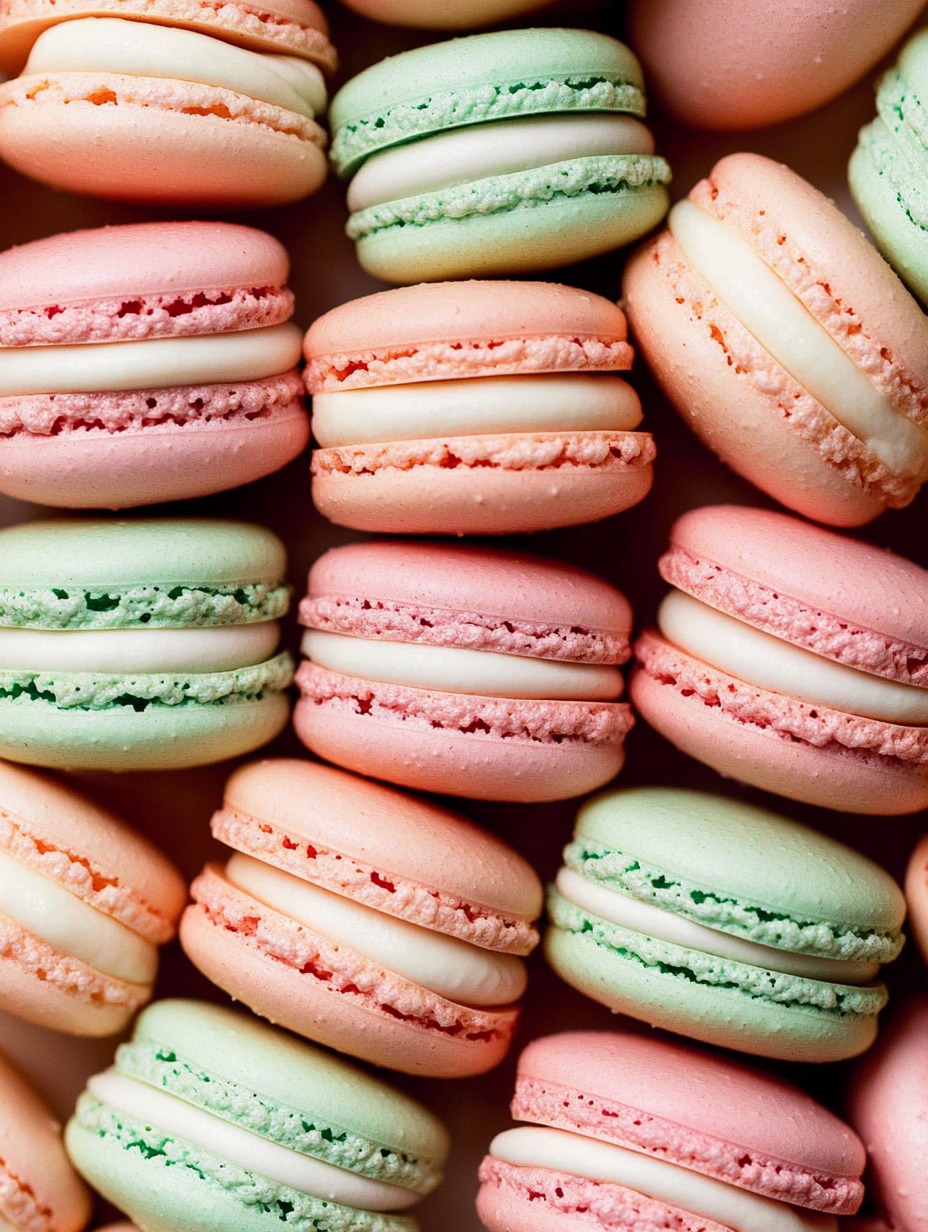 Pin it
Pin it
This hearty French macaron recipe has become my signature dessert for special occasions, offering that perfect balance of crisp shells and chewy centers that makes these treats so irresistible.
I first attempted macarons during a particularly rainy weekend when I needed a kitchen project. After several batches and learning from every mistake, these have become my most requested recipe when hosting dinner parties.
Ingredients
- Egg whites: Ensure the light texture and must be aged for best results
- Cream of tartar: Stabilizes the egg whites for a more reliable meringue
- Superfine sugar: Dissolves easily into the egg whites creating that perfect glossy meringue
- Extract: Adds subtle flavor notes; look for high-quality pure extracts
- Gel food coloring: Gives vibrant color without affecting the batter consistency
- Almond flour: Provides the characteristic flavor and texture; always use fine blanched almond flour
- Confectioners sugar: Sweetens and helps create the smooth top shell
Step-by-Step Instructions
- Prepare Egg Whites:
- Wipe down a glass or metal bowl with lemon juice or vinegar to eliminate any grease. Add egg whites, cover, and refrigerate for 24 hours. This aging process allows excess moisture to evaporate and proteins to relax, resulting in a more stable meringue. Bring to room temperature before using.
- Create Meringue:
- Add cream of tartar and extract to egg whites and beat on medium speed until very soft peaks form. The mixture will transform from foamy to a stage where beaters leave tracks. Gradually add superfine sugar in three additions, beating until stiff glossy peaks form that stand straight up without drooping when the beater is lifted.
- Prepare Dry Ingredients:
- Sift almond flour and confectioners sugar together thoroughly. This critical step removes any lumps and ensures the characteristic smooth tops. Use a spoon to work larger pieces through the sieve rather than discarding them to maintain proper ratios.
- Macaronage Stage:
- Fold beaten egg whites into the almond mixture in three additions. This gradual incorporation prevents deflating the meringue too quickly. Continue folding until batter flows like honey, performing the figure eight test where batter should take no more than 10 seconds to reincorporate when drizzled.
- Pipe Shells:
- Transfer batter to a piping bag fitted with a medium round tip. Pipe 1.5 to 2 inch rounds onto prepared baking sheets. Hold bag perpendicular to the baking sheet for even circles. After piping, firmly tap sheets on counter to release air bubbles that could crack shells.
- Rest Period:
- Allow piped macarons to rest until they develop a dry skin and no longer feel tacky when lightly touched. This typically takes 30 to 60 minutes depending on humidity. This skin formation is essential for proper rise and foot development.
- Bake Properly:
- Bake at 325°F for about 13 minutes or until macarons feel set when lightly touched. Proper baking develops the characteristic ruffled feet at the base while maintaining the delicate crisp shell and chewy interior.
 Pin it
Pin it
You Must Know
My favorite part of making macarons is watching the feet develop in the oven. The first time I saw those little ruffles form, I actually clapped with joy in my kitchen. Now I still peer through the oven door like a child watching a magic trick every single time.
Troubleshooting Hollow Shells
Hollow shells are among the most common macaron problems. They typically result from either undermixed batter that traps too much air or overmixed meringue that cannot support the structure. Ensure your meringue reaches proper stiff peaks but not beyond, and fold the batter just until it reaches the figure eight stage. Additionally, allowing the oven to preheat fully before baking helps prevent sudden temperature changes that can create air pockets.
Flavor Variations
While the shells themselves can be subtly flavored with extracts, the filling is where macarons truly shine with endless possibilities. For citrus variations, add fresh zest to buttercream fillings. Chocolate ganache can be infused with spices like cinnamon or cardamom. For an elegant touch, add a drop of rose water or lavender extract to white chocolate ganache. My personal favorite is a salted caramel filling with a sprinkle of flaky sea salt between the shells.
Storing For Perfect Texture
Macarons actually improve with a bit of rest time. After filling, store them in an airtight container in the refrigerator for 24 hours before serving. This resting period allows the shells to soften slightly as they absorb moisture from the filling, creating that perfect chewy texture. For longer storage, macarons freeze beautifully for up to a month. Thaw in the refrigerator, still in their container, then bring to room temperature for about 20 minutes before serving.
Frequently Asked Questions
- → How do I prepare egg whites for macarons?
Refrigerate egg whites 24 hours before use, bring to room temperature, and whip with cream of tartar to stiff peaks.
- → What type of sugar is best for macarons?
Use superfine (caster) sugar for dissolving into egg whites and confectioners' sugar in the almond mixture for fine texture.
- → How can I ensure the batter is the right consistency?
Perform the figure 8 test by drizzling batter. It should flow into itself within 10 seconds if properly mixed.
- → Why do macarons need to rest before baking?
Resting allows the tops to form a skin, which helps them rise and develop the classic 'feet' during baking.
- → What are some creative filling ideas for macarons?
Fill with buttercream, ganache, salted caramel, or fruit jams. Customize flavors to match the shell's coloring or event theme.
